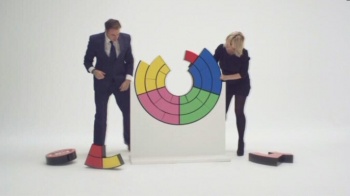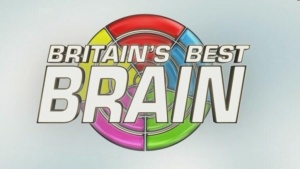Britain's Best Brain
Contents |
Host
Broadcast
Group M Entertainment and Tiger Aspect Productions for Five, 28 October to 16 December 2009 (8 episodes in 1 series)
Synopsis
Jamie Theakston and Zoe Ball host what is allegedly "television's toughest ever test", requiring contestants to perform feats of mental agility "in high stress conditions", in a series of five rounds, each specifically designed to test one of the five parts of the brain.
We are first introduced to the contestants. One by one they walk onto the set as their name, age and where they live are read out. Once assembled, some of the contestants engage in a brief conversation with the hosts about their background. Immediately after this, we are then reminded on a video screen of the contestants and their background. Perhaps the producers feel the audience's memory isn't good and they need an instant reminder of something that's just been covered?
Calculation
The first round involves the contestants answering ten increasingly difficult mental arithmetic questions displayed on a video wall. The catch is while they are doing this, various numbers moving around on the video wall behind the questions are distracting them. In addition a sort of white noise made up of several voices shouting random numbers over loud music is also played into the studio. The contestants only have three seconds to answer each question before they are timed out. Each question is worth 30 points, however in a pattern that will carry on into the other rounds, getting the question right is not enough to secure the points. The speed at which the contestants provide their correct answer dictates how many points they get, meaning they not just have to answer correctly, but also quickly. At the end of the round, what each contestant scored, their 'Brain Scores' is revealed, on a master scoreboard.
Co-ordinaton
The Co-ordination round is played out over the course of the whole show, slotted in between the other rounds. This involves the contestants being strapped into a gyroscope, while holding a virtual sandtimer. Once up to speed, the contestants must change the white lights to blue lights, by way of always pointing the blue end of the sandtimer towards the ground, which is obviously easier said than done while being spun upside down. The quicker they do this, the more of the 300 points on offer they score. The points scored here are added to each contestant's 'Brain Score' from the previous round.
Memory
This third round, which the contestants all play at the same time, is split into three parts. The first section sees a sequence of ten celebrities together with an unrelated object being displayed briefly on a video wall. After this, two celebrities are shown, and within five seconds, the contestants must answer which two objects they relate to. There are four questions in this section, with each worth 20 points, and like earlier rounds, answering quickly secures more of the points on offer. The second section of the round sees the objects from the first section being briefly displayed one after the other, as an unrelated sound being played. Afterwards, a sound is played again, and the contestants must answer which object the sound relates to. Another four questions here, with five seconds to answer, and up to 25 points available. In the final section of the round, various sounds from the second section are played again, and the contestants must answer which celebrity that relates to. To do this, they must relate the sound back to an object, and then relate the object back to the celebrity. This section also comprises four questions, with five seconds to answer, but offers up to 30 points per question for a correct answer. After this, the points scored are transferred over to the master scoreboard.
Recognition
This penultimate round is divided into two sections. The first section sees a diagram composed of three overlaid shapes being displayed on the video wall in front of the contestants. From a selection of eight possibilities, the contestants must decide which three shapes make up the diagram. Each of the three questions requires the contestants to answer within 10 seconds, with up to 60 points on offer per correct answer. The second section of the round, which is a glorified spot-the difference, sees the same photo being shown on the video screen for a few seconds, before fading to grey, and being shown again for a few seconds, this time with something missing or altered. A correct answer within 10 seconds rewards the contestants with up to 60 points, with two questions being played in this section. In common with the other rounds, the points scored here are taken over to the master scoreboard.
At this point, the results of the now complete Co-ordination round are revealed, and are added to the master 'Brain Score' scoreboard.
Risk
In the final round, the contestants all stand around a large balloon. When the round begins, the contestants must keep a button in front of them pressed down for as long as possible without the balloon bursting, as it is rapidly filled with air. Each contestant can see the current volume of air in the balloon on a screen, and we are told the typical bursting point of the balloon is around 4500 litres. Clearly however this is no guarantee that it will not burst before or after this mark. Should the balloon burst and any contestant still be pressing their button, they score zero. However the shorter the period of time between the contestant walking away from their button, and the balloon bursting, the more of the 300 points they receive. As such, simply being the last person standing is not a guarantee of banking the 300 points, particularly if the balloons continues to fill for some time after you have walked away.
In addition, the contestants are aware of their competitors scores, meaning tactics and strategy very much come into play in the round. Once the balloon bursts - whether or not any players are still pressing their button - the round ends, and the points (if any) each contestant scored are calculated, and added to the master 'Brain Score' scoreboard.
After this the winner is revealed. However all of the contestant's Brain Scores are added to a series-long overall scoreboard, with the highest five contestants from across the series taking part in the final. This means that even if you finish last in your heat, you could still take part in the final, if your score is no lower than fifth highest by the end of the heats. Conversely however, it also means you could win your heat, and fail to qualify for the final if enough contestants in later heats score higher than you. Although this allows for more than one contestant from a given heat to progress to the final - a good thing if there are two or more really good contestants - it also somewhat undermines the kudos of winning your heat. Perhaps a token prize for the winner of each heat would remedy this situation?
Overall Britain's Best Brain is an enjoyable way to spend an hour, perhaps mostly because of the slightly different approach it takes to the gameshow format. The hosts work well together, and although it hasn't set the ratings alight, that should not be viewed as an indication of the quality of the programme, which remains good throughout.
Champion
Matt Clancy
Trivia
Part-funded by Japanese computer games company Nintendo.

To promote the show, Jamie and Zoe made their show's logo out of jigsaw pieces in a clip shown before programmes on Five, including their own


